We’ve just managed to make what we think is the first linked crossing of Vaeroy and Rost in the artic islands of Lofoten in Norway.
The two crossings are about 35 km each and the first involves crossing the infamous maelstrom of Moskennes island.
Myself and Jann Engsted, a local guide who has been guiding on the Islands for 30 years, made the two crossings an ambition he has been trying to do for a long time.
We had ocean swell moderate winds and a fair deal of fog on the first crossing , but otherwise a great few days.
The new Palm Oceana gear performed well and kept me cosy and dry.
Olly Sanders

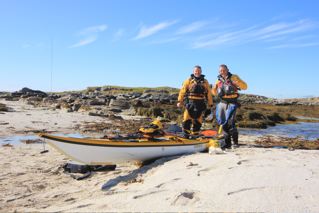

Is the Wilderness system Tempest a fast boat, is it stable and can it deal with the rough stuff ? Well I raced a plastic tempest 170 down the river Ness last weekend in the annual Ness marathon 2011 short course and managed to win, beating the other entrants and coming only 30 second slower than the course record which was set in a wild water racer, so fast yes, good for the rough stuff, also yes it handled the standing waves and rapids superbly, and almost as fast as a racing boat without needing a change in underwear afterwards, though its noted I need to put more effort in next year. The sea kayak challenge is now set with Wilderness Systems now holding the Ness Marathon sea kayak course record, ideal fitness training for those longer journeys. See you there next year – Steve Mackinnon




Great Glen Canoe trail by Sea kayak, not just any sea kayak though, Wilderness System tempests, fast, stable and well behaved in all conditions. Enough grub to last out the whole trail without having to scrimp and save. Its not just an open canoeists paradise, its well suited to sea kayak journeys as well, no nessie shots though, sorry – maybe next time. Other photos attached, enjoy – Steve Mackinnon
On Earth Day (April 22) of 2010 Dave Freeman and I began a three year, 11,700 mile journey across North America by kayak, canoe and dog sled. Our goals are to increase awareness and promote conservation of North America’s waterways and wild places while actively engaging over 100,000 elementary and middle school students in the journey though our website and live school assemblies.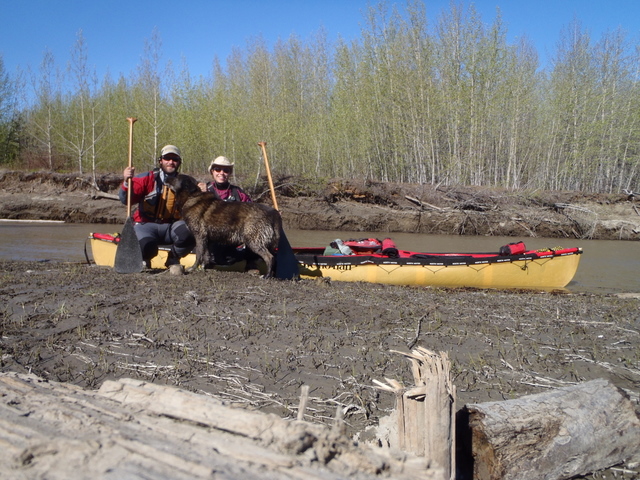
The odyssey began by kayak on the Pacific Coast studying temperate rainforests and marine life of the Pacific Northwest, but this was just the first in a series of six stages on their quest to highlight North America’s wildest places.
After kayaking 1,400 miles from Seattle, Washington to Skagway, Alaska, we progressed over the history-studded mountains in the footsteps of the Klondike Gold Rush, to the Mackenzie River delta. From there, we dog sledded south and are currently canoeing from Great Slave Lake toward Ontario. Then we will kayak through the Great Lakes and follow the annual whale migration past the salt marshes and sea turtles of the Atlantic Coast, finishing in the mangroves and coral reefs of the Florida Keys.
As you read this, we are somewhere in central Canada, working our way south and east in our canoe with our travel companion and favorite sled dog Fennel. To follow our progress and virtually immerse yourself in the expedition, check out www.NorthAmericanOdyssey.com. We are very excited to join the Palm Equipment Team and we will post regular updates on the blog.
This marks the first summer I haven’t traveled out west in a long time. The west coast gets all the glory for summertime paddling in the US and rightly so as California, the Pacific Northwest, Idaho, Montana and Colorado are all at their prime right now. However it doesn’t mean that you can fully overlook the right side of the country as there are plenty of quality options! Also as I’m still in the process of healing a herniated disc the East Coast offers me some great summertime paddling close to home and a chance to get to some places I haven’t been in a while.
The best part about kayaking in the East in the summer is the heat, and that means day after day in a shortie! It’s pretty good to be on a creek run without a dry suit and a bunch of fleece. Many folks think that the water goes away here with the end of spring, not so. Summer time thunder storms, some timely dam releases, and just plain big rivers lend themselves to great paddling all the way through the dog days of August.
This year with the start of the first heat wave I packed up the van and headed North for my first paddling trip since finding out I had a herniated disc. It’s been really good to be back on the water and traveling, two of my favorite things in life. Enjoy the pictures!
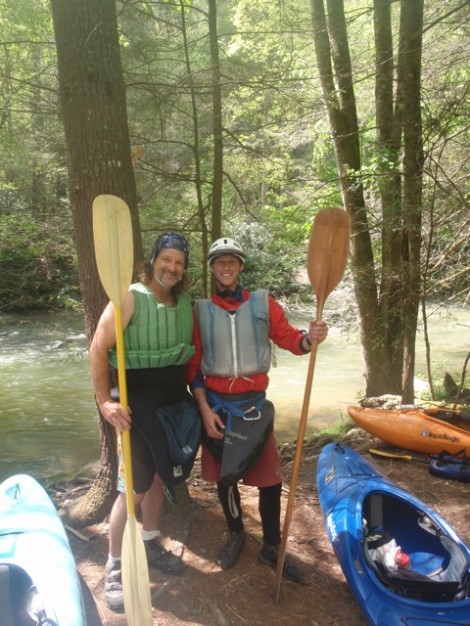
Wouldn’t be complete without a little Green River action in here. The Green is one of the best rivers ever in the summertime, lots of releases, good drops, and warm temperatures. Shane and I at the put-in on retro day.
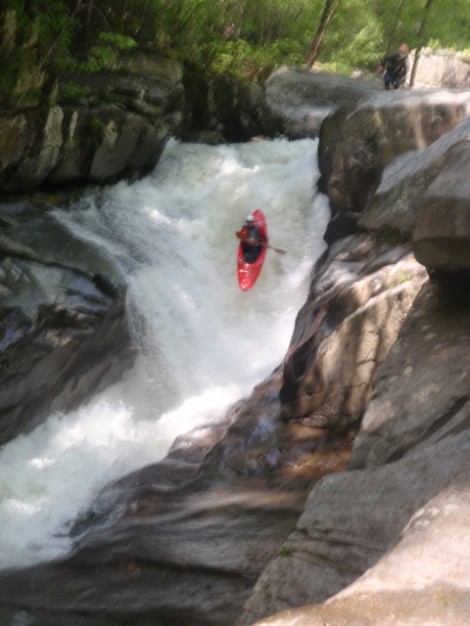
Rolling over Gorilla on Retro Day, good to be back in a boat and stomping this rapid. A 90 degree offset….well that was a little more challenging!
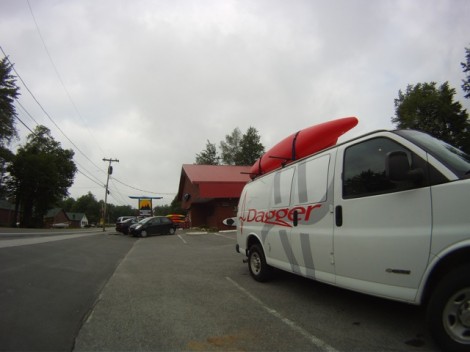
The van outside Moutain Man Outdoor Supply Company in Old Forge, New York home to the Moose River. Due to a lucky lightening strike the power plant was releasing water into the Bottom Moose which allowed me to get my first ever run on this iconic Adirondack river. It didn’t disappoint!
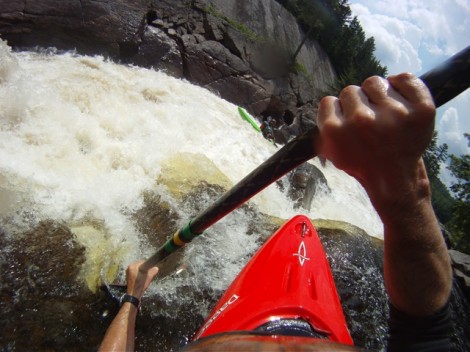
Lining up a boof on the Bottom Moose, I can’t believe it took me 20 years to get on this run. Glad I got to it I felt like I’d been doing the East Coast an injustice:)

Following Will Crimmins down Sure Form one of the great slides on the Bottom Moose

Another takeout after another great day on the water!
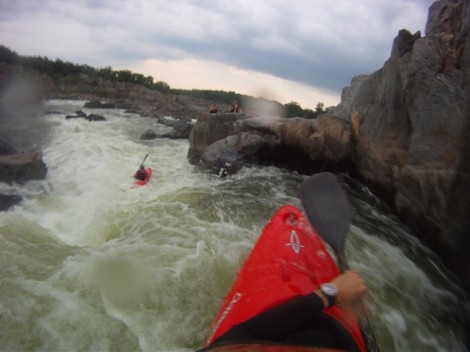
The view from Grace Under Pressure on Great Falls, Potomac River. Great Falls and the Potomac are one of the great urban jewels of East Coast kayaking. 20 miles downstream of this boof is the Whitehouse. It’s pretty cool kayaking resource as it has something for all levels of paddling right outside of Washington DC.
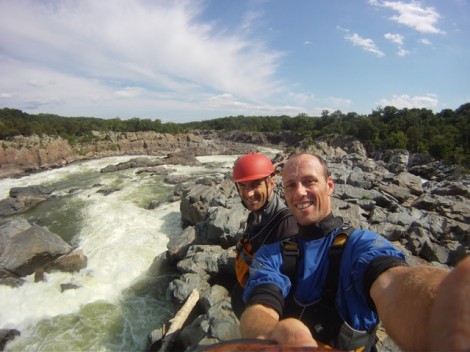
My cousin Ben and I at the Center Lines on Great Falls.
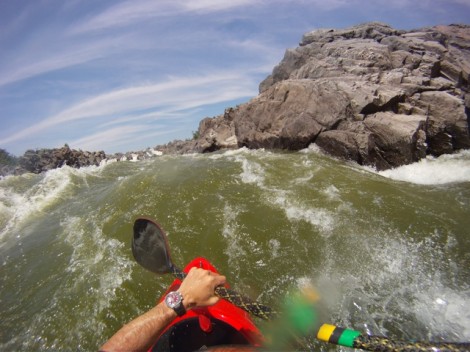
Shredding the O-deck waves in my Axiom! Great waves and great boat!
I think two of my favorite parts of a good road trip are the people you get to see and the random things you end up doing. It’s good to have a plan sometimes but sometimes you just gotta go with the flow….
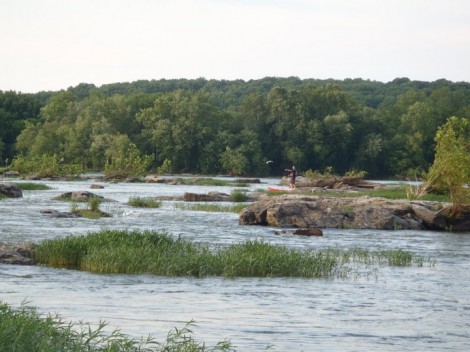
Stand up Paddle Boarding on an upper section of the Potomac
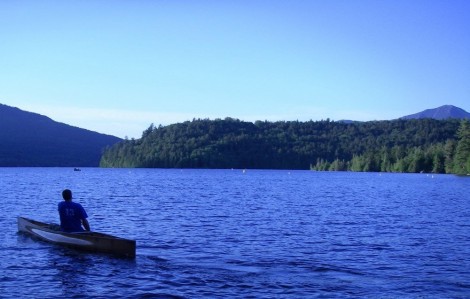
Evening on Lake Placid, New York. Can’t be afraid of some different craft, my friend Christian paddling home after drinks at the Lake Placid Lodge
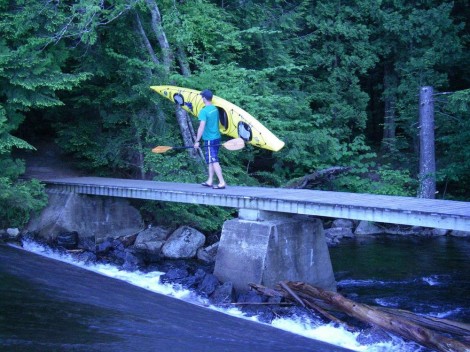
Speaking of different craft to where am I going with this again?…..

Never be afraid to take advantage of croquet
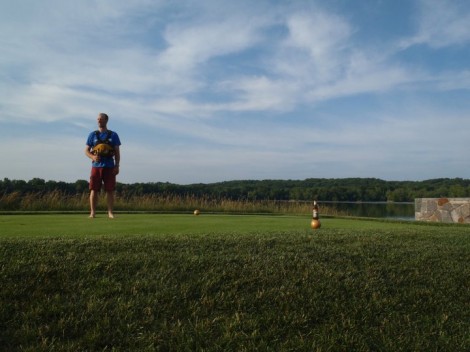
And above all never go anywhere without your PFD
Catch you next time and happy paddling on whatever craft this summer!
A new association to represent L5 coaches who are also active paddlers in their discipline has been formed.
Please check out www.apcpaddlerscoaches.co.uk for details. Many Palm paddlers are already on the list.

Who are the A.P.C?
The A.P.C is a collaboration of Level 5 coaches across disciplines that provide the highest level of coaching and the training and assessment of NGB awards. These coaches are also active paddlers having their own adventures in their spare time, be it in the UK, Europe or on expedition. Membership is open to any L5 coach be it a freelancer or in full time employment, who is an active coach working at a range of levels and who is an active paddler in their free time.
The L5 coach is the highest coaching award in the UK and at the moment there is no independent organisation to promote their services. The aim of the logo and the website is to provide a simple way of identifying the highest levels of coaching from active paddlers passionate about their sport. Our members are chosen by their peers and the criteria ensures that not only are they L5 coaches, but they are active in their chosen discipline.They provide evidence of this which has to be updated every 2 years to retain membership. This ensures you get the highest quality coaching from active passionate paddlers.
Nige Robinson, Olly Sanders and Sid Sinfield have just returned from a successful trip in Greenland. The trio circumnavigated the large island of Nutarmiut, a distance of almost 300 km and also put up 3 new mountain climbs. The climbing, camping gear and food was squeezed into the boats for the 3 week unsupported trip. The Aleutian drysuits and other Palm gear was great.
Look for a full report in the paddling press soon.
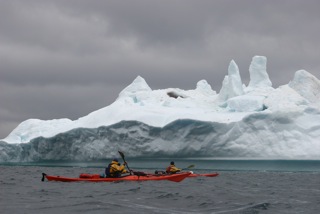
After a 3 weeks successful expedition around the north west corner of Spitzbergen our camera is as loaded of megapixels as our heads of impressions and new experience. Weather changes fast, wind is strong and the trip could have taken a month. By turning night into day (paddling and sleeping when possible…) we managed to cover 550K in 16 days. That including a 30K “kayak hiking”- crossing a glacier with our boats. Here is a taste of the adventure:


14 polarbears… some close to the camp and had to be scared away with flare-guns. These two friendly sweeties were just passing by…
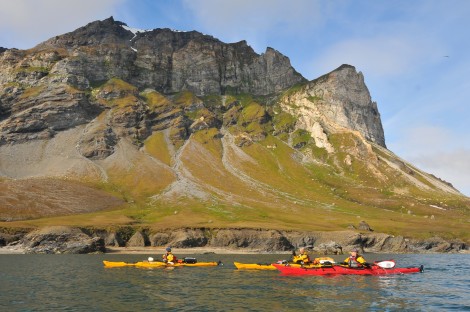
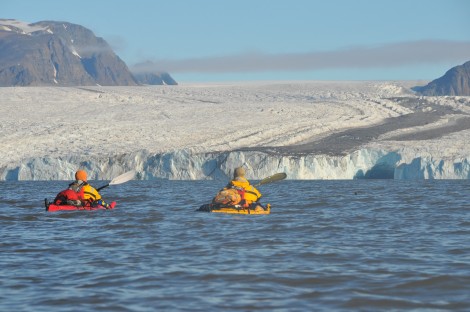
The majestic Mittag Leffner-glacier had to be crossed – or we had to return and paddle 450K back…
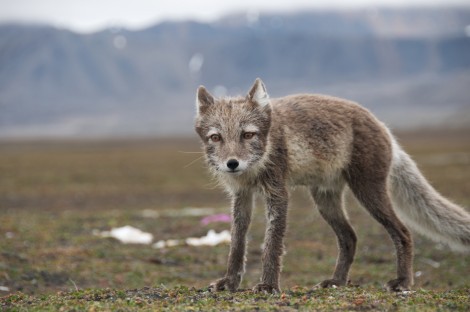

12hrs of hard work crossing morains and glacier rivers, to get on to the high point.
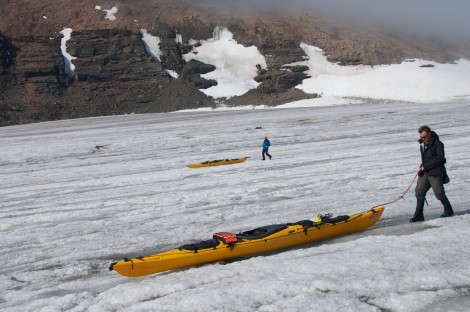
Down the Ragnarglacier was like walking the dog.

Rafting down a dirty glacier-river for 6 hrs was much better than to carry all the gear down the moraine (would be a 2 days struggle). And off course we were were dry and comfortable in our suits.
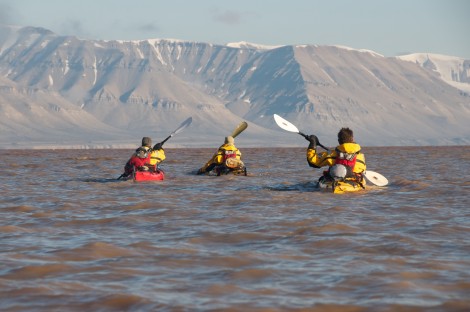
At last we reached the Billefjord and continued the trip.
After our first polarbear encounters a couple of days we have now met a total of 14 during a 2 day period. Most we have met while we paddled by, while 3 have been while we were on land at our camp a couple of nights ago. Those we met while in the boats gave us the best opportunities to get quite close too them. It is incrdible to watch these animals casually strolling or swimming totally relaxed in their turf. In contrast, we are very aware that their environment can be deadly to us in a few minutes as we have already seen with the seas, wind, cold that continue to change in minutes.
After 2 days of many bear sightings we were on higher alert and had found a camp site with several hundred meters of open ground to give us plenty of warning of approaching bears. We also decided to have one of the team on bear watch all night. The first bear made an appearance several hundred metres from camp an hour after our arrival. Per Thore and Petter headed out in his direction and sent him away with a warning flare.
It was then decided that we were possibly camping on a popular path for the local bears, and that if we had another bear visit we would pack up camp and move 25 km’s across the fjord. Sure enough a couple of hours later (12.30am) camp was woken by bear watch and another bear was heading our way in the other direction from the first. The boys sent the second bear away, but he needed more convincing than the first (1 flare plus several warning shots overhead). So at 2.00am we paddled out from camp under blue skies and an oily sea.
We had an amazing 4 hours paddling under the midnight sun. We were visited by many seabirds, a couple of seals and a pod of minkie whales before making camp just just inside Widjefjord.
When we woke 8 hours later we got news from home that a couple of fellow paddlers who were attempting to circumnavigate the whole Svalbard group had been rescued about 250 km’s further east after one had been attacked in his tent and dragged 30 meters before being shot by his mate. The latest is that he is in a serious but stable condition in Tromsø hospital. Our thoughts are with these guys and mood in our camp is a little subdued. We are in an unforgiving environment.
We write this update while taking shelter in a hut 30km’s inside Widjefjord as 15meter/second blow from the south. We’ll be here until the wind drops.
“Team Lost”
Widjefjord North-West Svlbard
Petter Thorsen sent us this update from Day 8 of their Svalbard Expedition, including their first polar bear sightings.
Team ‘Lost’ have been Found!
Since we last sent an update we have been taking advantage of continual talewinds and paddling up to 40 or more km’s per day!
After leaving Longyearbyen on July 20th we paddled west before reaching Forlandsund the following day. It was a strange and lonely feeling knowing that we were heading north, away from civilisation and into a wilderness area that is both beautiful and extreme. The dark sky towards the north didn’t help!
In the last few days we have paddled up the entire western side of the Svalbard Islands, past hunting huts and grave yards of polarbear, whale, seal & fox hunters dating back 500 years. We have paddled past more glaciers that I can count, and been caught in wind squalls that sprung up from nowhere and nearly flattened our tents.
“Lost” had a bet the the first to predict which day we would sight our first polar bear would win a bottle of whiskey…but I and sorry to report that no one won. We all expected to see a polarbear in the first week of the trip…but none materialised…..UNTIL TODAY (day 8)!!!! And not only did we see one, but 8!!! With the last 2 being a mother and baby walking along the sea shore less that 50 meters away from our kayaks. What incredible animals…and there are only about 3000 left on the svalbard islands.
We have got into a pretty good routine for each day now; beginning with dried cereal which we just add water to make a super energy meal that keeps us paddling for several hours without stopping. We then check the weather forecast via satellite telephone to decide when we paddle and where (if any emergency stops are) as the weather changes quickly and with potentially dangerous consequences. We then break camp, take down the polarbear trip wire flares, pack boats and get on the water. We are using Aleutian dry suits from Palm, which we always wear on the water with up to 2 layers of clothes underneath. The secret with staying safe and warm is to manage your body temperature so well that you don’t sweat, or if you do; paddle yourself dry afterwards. And we have found that these dry suits have been amazing at breathing without letting water in.
Once on the water we usually try to paddle for 2 shifts of about 4 hours with a lunch break inbetween where we stop, boil water and eat hot lunch. At the end of each day we then send 2 of the boys on land with guns and polarbear flares to check none are in the area, before landing and setting up tents before we begin to freeze. Then its setting up of polarbear flares around the camp, drying equipment, eating, and sleeping!
Until next time!















































